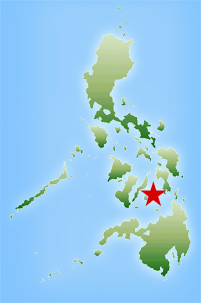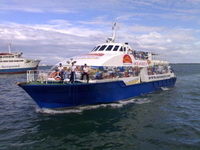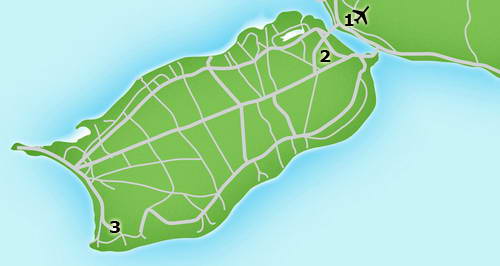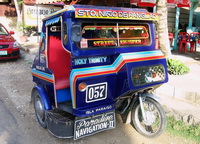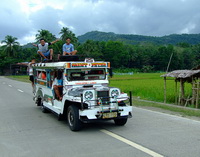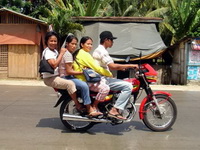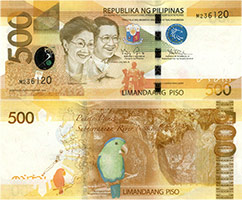General Info
Bohol is a province in the Philippines regarded as one of the top tourist destinations in the country. It consists of Bohol island (the mainland) and 75 smaller islands, with Tagbilaran City as its capital and center of trade and commerce.
Bohol is considered as a prime tourist destination, attracting visitors from all over the world to its beautiful natural and cultural wonders. Among its famous tourist attractions are the world-famous Chocolate Hills -- a motley collection of over a thousand dome-shaped hillocks; the endangered tarsiers -- one of the world's smallest primates; and the white-sand beaches of Panglao Island.
Aside from its natural beauty, Bohol is also home to various historical and cultural riches dating back to the Spanish colonial era. Limestone churches, museums and monuments such as the Blood Compact Shrine are all worth visiting.
Bohol is a favorite of vacationers and tourists, some of whom have stayed for good in the island paradise.
Geography
Bohol is the Philippines' tenth largest island, with a total land area of 4,117 square km. It is located in Central Visayas (Region 7) surrounded by Cebu and Negros islands to the west, Leyte island in the east, and Mindanao in the south.
Bohol is dominated by hills and plateaus. There are no dormant or active volcanoes. The uplands in the interior are ideal for agricultural and forestry while the lowlands in the central and northern areas of the island are known for its fertile grounds and excellent water resources.
The towns of Carmen, Sagbayan and Batuan in the central portion of the main island are dotted with thousands of limestone hills. These hills are widely known as the Chocolate Hills, because they turn chocolate brown during the scorching hot summer. The Chocolate Hills is considered as one of the natural wonders of the world and attracts tourists from all over.
Bohol is home to many rare and endangered species of flora and fauna, one of which is the famous tarsier (Tarsius syrichta), one of the world's smallest primates. The seas surrounding Bohol and the second largest island, Panglao, is also home to some of the world's richest marine life.
Balicasag Island near Panglao is famous for its endangered whales and dolphins that has attracted tourists for sightseeing tours. White sand beaches are common in the coastlines of Bohol, particularly in Panglao Island, where popular beach resorts are located.
The four main rivers of Bohol are the Loboc River (also known for its river cruises), Inabanga River, Abatan River and Ipil River. There are also caves and waterfalls, such as the Hinagdanan Cave in Dauis and the Mag-aso Falls in Antequera.
Weather
Amihan - High Season
September/October to June/July
28-38°C (82-100°F)
Hot and humid, Northeasterly to Easterly winds, little or no rainfall
Habagat - Low Season
June/July to September/October
25-32°C (78-90°F)
Cool south-west wind, moderate to heavy rainfallBohol is surrounded by other larger islands, so it is often spared from the harmful effects of typhoons and cyclones. The island enjoys a tropical climate all year round.
Tourist Season
The Low Season is when the southwest monsoon (Habagat) occurs, featuring unpredictable weather and occasional rain showers. During this time, the beaches are not so crowded and hotel prices are lower, so the budget-conscious tourist can take advantage of this fact. The low season begins in June, and ends in October.
High Season is when the northeast monsoon (Amihan) prevails. During this time, the climate is mild and cool, with daytime temperatures hovering around 28° Celsius and 25° at night. It is also winter in the northern hemisphere, and tourists come in numbers in search of sun, heat, beach and party. High Season starts in October and ends in June.
The Peak Season is when the tourists are at their height. This includes Christmas, New Year, Chinese New Year, and Holy Week (Easter Week). Some resorts have a +10% to +25% premium on their rooms, and the island gets fully booked. Make sure you book as far in advance as possible.
Getting There
Bohol is accessible both by air and sea. Several domestic airlines offer direct flights to Tagbilaran City, the capital of Bohol. You can also reach Bohol through passenger ships and ferries plying the routes between coastal cities and towns.
By Air:
If you are from outside the Philippines, you can take a flight to either Manila or Cebu before taking another flight or boat ride to Bohol. Cebu is preferable to Manila since it is closer, but only a few international flights arrive there. After arriving in Manila, you can take any of the daily domestic flights to Tagbilaran City which takes about an hour and fifteen minutes. Philippine Airlines (PAL), Cebu Pacific and Air Asia offer regular flights from Manila to Tagbilaran.
Airlines that serve Tagbilaran from Manila/Cebu (in order of price for early booking):
By Sea:
Ferries and ships are obviously slower than aircraft, but they can save you a whole lot of money. If you are in Manila, you can also take a boat ride via Superferry, which is cheaper but takes more than 24 hours to arrive in Tagbilaran City seaport.
If you're in Cebu, you may choose to ride a fast catamaran ferry (also known as "fastcraft") to Tagbilaran City seaport. This usually takes about an hour and a half, and costs more or less 500 pesos. Supercat and Oceanjet are some of the operators of fastcraft trips to Bohol. If you're on a tighter budget, there are slower ferries that can take you to Bohol at less than half the price of fastcrafts, but they usually arrive in four hours.
Shipping Schedule:
There are also boat rides to other seaports of Bohol in Tubigon or Talibon, in the northern part of Bohol. They are a lot cheaper than boat rides to Tagbilaran City because they are closer to Cebu City. After arriving, you can then ride a van or bus to Tagbilaran City or any other town within Bohol. Since Bohol is already a popular tourist destination, it's not hard to find regular boat or ferry trips to Bohol from your place.
Getting In
1. Cebu Airport to Tagbilaran City – After getting out of the Cebu Airport, there will be a line up of taxis. The ride costs PHP200 for the trip to Pier 4. You will then have to take a ferry. All ferries take 90 minutes to get to Tagbilaran City. Schedules and fees can be found on the ferry's website (links in the "Getting There" section).
* Note: There are also planes that fly directly to Tagbilaran City Airport. There are scheduled flights from Mactan International Airport (Cebu) to Tagbilaran City, which takes about 25 minutes, while that from Ninoy Aquino International Airport (Manila) takes about 1 hour & 15 minutes.
2. Tagbilaran City to Panglao – Once in Tagbilaran City, you may opt to either take a taxi or a tricycle (a small motorcycle cab) to your hotel. Taxis are few in Bohol so your best choice is to flag down a tricycle. Tricycles have no meters unlike taxis so you have to inform the driver of your destination and agree on a fixed rate. As a rule of thumb, you should pay no more than 7 pesos per kilometer for every trip, regardless of the number of passengers. For routes outside the city you may choose to ride the jeepneys and multicabs.3. Panglao Island – Guests going to Panglao Island, particularly Alona Beach, can have their hotel pick them up in Tagbilaran City airport or pier for an additional fee. Alternatively, they should be able to get a taxi at a reasonable cost as well (PHP400 to PHP600).
Getting Around
Getting around Bohol can be quite tricky, but as long as you remember a few bits of information you can move around easily and safely.
The major mode of transport in Tagbilaran City and other places in Bohol is the tricycle, a small cab powered by a motorcycle that can accommodate up to 3 passengers. Tricycles are usually limited only to the city or town where they are licensed to operate, but in some cases they can convey you to neighboring towns. The normal rate for tricycles in Tagbilaran City is 7 pesos per kilometer.
Aside from tricycles, there are also jeepneys and multicabs plying their routes within the city and outside. Jeepneys are colorful jeeps with two long benches opposite each other. Sometimes, wooden benches are placed in the middle to accommodate more passengers, but this makes it difficult for passengers to disembark. Multicabs are plain-looking vehicles that resemble a small van, but it has open windows just like the jeepneys.
Sometimes, there are places in Bohol that cannot be reached by common modes of transportation like the tricycle or bus. Habal-habal (motorcycle) drivers are popular among rural folks because of this reason. However, riding a habal-habal is not always a safe choice because of its illegal, unlicensed nature and sometimes drivers tend to drive fast without any head gear.
Money
The currency is the Philippine Peso (PHP). Bill denominations are : 20, 50, 100, 500 and 1,000 pesos. If possible, bring your cash in 500 PhP denominations as you will find that getting change for 1,000 PhP bills is at times difficult. ATM machines can only dispense in 500 PhP bills. There is a BPI ATM on the way to Alona Beach in Panglao Island, and a number of them located at different sites in Tagbilaran City.Foreign Currency is best exchanged at the banks or money changing stores. Only the larger restaurants and hotels accept credit cards including MasterCard, Visa and American Express, although a 5% surcharge on credit cards is standard. Personal checks are generally not accepted.
Communication
Bohol is serviced by two of the country's largest mobile providers, SMART and GLOBE. They have good reception throughout the city, and around Panglao Island. Visitors can purchase a SIM card with a phone number for 65 PhP and then purchase loads (user minutes) in amounts as low as 10 pesos. Text messages are definitely the main form of local communication at a cost of 1 peso per text. (The Philippines is the text message capital of the world). Talk time is more expensive between 6 to 8 pesos per minute. International text messages are quite affordable (most countries 20 PhP).
Landline calls are cheaper, and best for international calls. Some resorts also have international phone service, but generally at higher rates. Philippine country code is +63. Tagbilaran's area code is (38). Bureau of Immigrations number in Tagbilaran City would be +63 38 235-6084.
Many hotels also have WiFi internet connection, some restaurants have WiFi hotspots, and internet cafes are also scattered around the island. Getting online shouldn't be a problem, although speeds are going to be slow and subject to interruption.
The Post Office as well as the major courier service offices can be found in Tagbilaran City. This is about 30 minutes away if you happen to be in Panglao Island.
Visa Extensions
The Bureau of Immigration (BI) can extend visitor visas as well as process other changes required in visa status. For visa extensions you will be required to make photocopies of your passport and fill out a visa application form. The cost varies depending on your visa and desired length of stay. You can expect to pay around 3000 PHP for a one month extension. There is a dress code so don’t wear board shorts or tank tops. Located on 2nd Floor Sarabia Co, Torralba Bldg. CPG Ave., Tagbilaran City, best to go on Mondays and Tuesdays, 8AM - 12NN and 1PM - 5PM. For more information call +63 38 235-6084.
